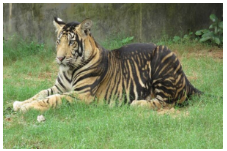
In News
- A rare melanistic royal Bengal tiger, popularly known as black tiger, was found dead in the Simlipal National Park.
- The population of black tigers in Similipal is very limited (eight tigers as per theTiger Status Report 2018). The death can affect the breeding of tigers in the region.
Black Tigers
- About:
- They are a rare color variant of the tiger and are not a distinct species or geographic subspecies.
- The melanistic royal Bengal tigers are distinctive because of the colour of their fur. Their white fur is caused by a lack of the pigment pheomelanin.
- Reasons of Melanistic Nature:
- The black tigers are mutants; they are Bengal tigers with a single base mutation in the gene Transmembrane Aminopeptidase Q (Taqpep).
- Melanistic tigers tend to grow faster and are said to be heavier.
- The main cause of the rare mutation is genetic drift. Due to this geographic isolation, genetically related individuals have been mating with each other for many generations in Similipal, leading to inbreeding.
- Black tigers outside of Similipal:
- They exist at the Nandankanan Zoological Park in Bhubaneswar, Ranchi Zoo and Chennai’s Arignar Anna Zoological Park, where they were born in captivity.
- Genetic tracing proved that these captive-born tigers shared a common ancestry with Similipal tigers.

Simlipal National Park
- About:
- It is one of the largest biospheres in India. It is a national park and a tiger reserve (designated under project Tiger in 1973).
- It derives its name from ‘Simul’ (silk cotton) tree.
- It was declared a biosphere reserve by the Government of India in June 1994.
- UNESCO added this National Park to its list of Biosphere Reserves in May 2009.
- Simlipal has the world’s highest rate of black tiger sightings in the world.
- Location:
- Northern part of Orissa’s Mayurbhanj district.
- It lies within two biogeographical regions: the Mahanadian east coastal region of the Oriental realm and the Chhotanagpur biotic province of the Deccan peninsular zone.
Source: DTE
Previous article
J Slab Track System
Next article
Vivad se Vishwas Scheme